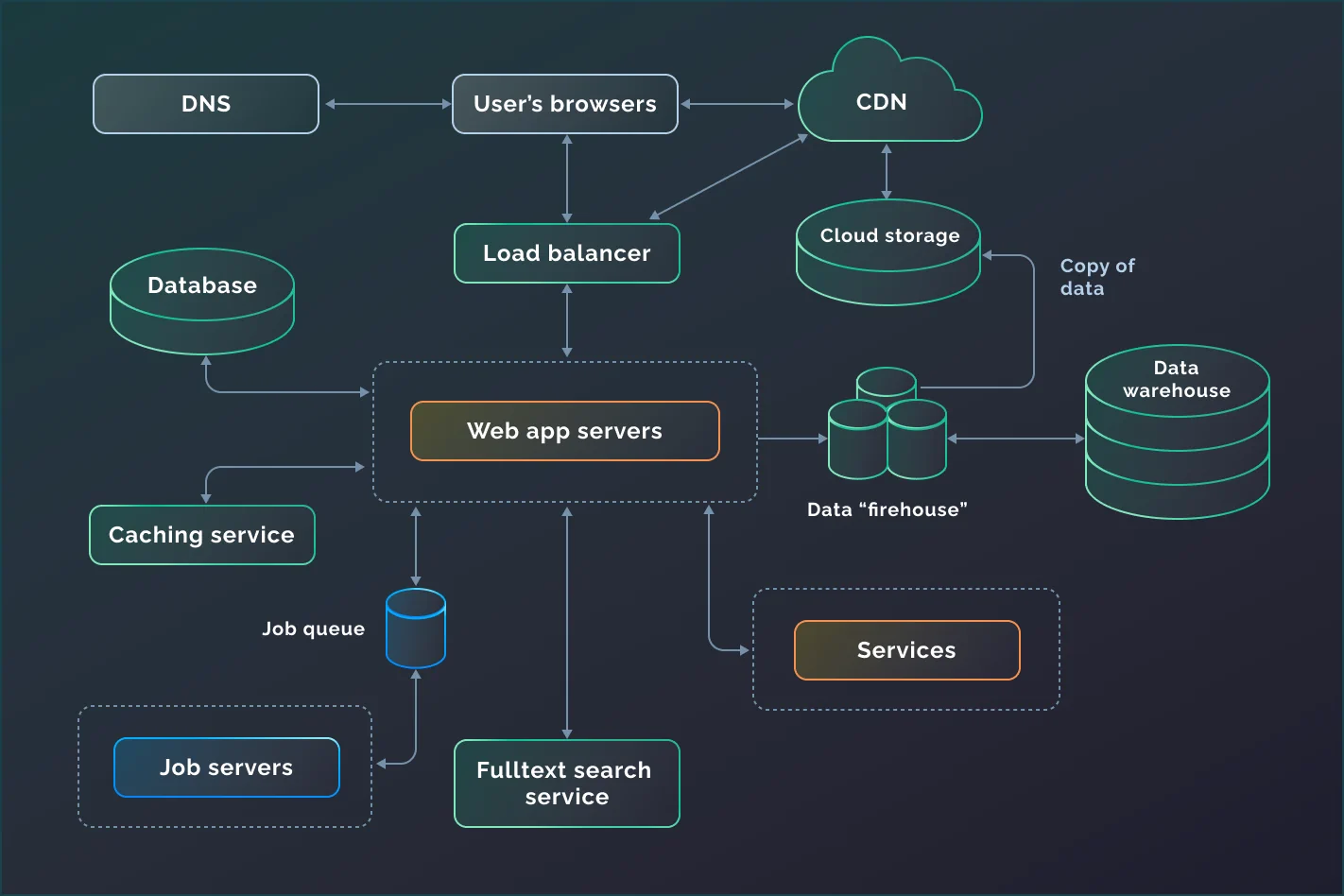Web Application Architecture: Guide 2025

In our technology-driven age, enterprises can achieve business success only by digitalizing their workflows. Together with mobile apps, web applications form the backbone of contemporary IT infrastructure, helping organizations manage their internal routines and perform customer-facing operations. To maximize the efficiency of these software products, companies should understand the fundamentals of website system architecture.
This article explains what web architecture is, presents a web application architecture diagram to illustrate its underlying principles, describes its key components and types, advises on selecting the right application development services, and outlines emerging trends in modern web app architecture that will carry the day tomorrow and beyond.
Web App Architecture in a Nutshell
Like any other solution architecture, web app architecture is a model that determines the way its elements interact with each other. This is a sort of the web product's skeleton, uniting all its systems, databases, interfaces, and other components to let the app perform its functions. But that is true of any software architecture, you may say. How does web application structure differ from traditional software architecture?
First, a web app can be accessed through a browser from any device with an internet connection, whereas traditional software must be installed on the gadget and tailored to suit its operating system. Second, being cloud-hosted products, web apps are more flexible in handling various traffic volumes, whereas traditional software may find upscaling quite challenging. Third, during web development, architecture can be built quickly by employing server-side tools and frameworks; traditional software is longer and harder to create. Finally, web apps are less expensive to develop and deploy than traditional software solutions.
The interaction of web app features is demonstrated in the following web architecture diagram.

Let’s go through the items it contains.
DNS
The Domain Name Service is responsible for receiving requests sent by users to the server. DNS acts as an address book that helps computers locate each other on the Internet by matching their IP addresses to domain names.
Load balancer
This feature directs all user requests to multiple servers, thus orchestrating a more even distribution of the traffic and preventing faults caused by excessive load from simultaneous requests.
Web app servers
They process requests and send responses back to the browser they come from, leveraging the database, job queue, cache server, and other elements.
Database
It not only stores data. It is equipped with various instruments to organize, retrieve, update, and present entries the web app utilizes.
Caching service
It is a great performance booster when it comes to the retrieval of frequently accessed data. Since such search results are cached, the web app finds them instantly.
Job queue and full-text search service
These are depicted on the web app architecture diagram, but they are optional features. The first is highly valuable for handling large amounts of tasks that streamline job processing. It creates a queue of jobs that wait to be executed according to a certain schedule. The second enables text searches by combing through huge datasets and identifying the necessary content by a keyword.
Services
These appear in more complex solutions, functioning as standalone applications that interact with the primary app, augmenting its responsiveness and capabilities.
Data warehouse
To reach this, data flows through a “firehose” via a continuous stream. Inside the DWH, data management occurs when the information is processed and structured, while additional data is stored within scalable storage under strong security protection.
CDN
It stands for Content Delivery Network and is designed to streamline access to various files by distributing them across servers worldwide. When a user needs CSS, JavaScript, HTML, or image files, they can swiftly retrieve them from a server nearer to them than the application's central database.
All these features are united into several basic components within the entire system.
Key Components of Architecture for Web Application

Web development architecture is arranged into three layers.
Presentation layer
Also known as the front-end or client layer, it houses static and dynamic visual elements (menus, buttons, images, text) located on the interface and visible to the user. It also includes user process components that execute logic and manage interactions. Technologies that help implement this layer include programming languages such as HTML, CSS, and JavaScript, as well as various frameworks (e.g., React, Vue, Angular).
Business layer
Other names for it are the application layer, back-end, or server-side of the app. It relies on the web, application, and database servers to process user requests received by the client side and manage business logic. A typical tech stack for building the business layer consists of back-end frameworks (Django, ASP.NET, Spring, Express.js, Flask) and languages (C#, Python, Java, PHP).
Data access layer
It is closely linked to the web app's back end, providing information for it from various databases. The latter can be relational (e.g., PostgreSQL or Microsoft SQL Server) or non-relational (MongoDB, Redis, and others).
Other elements, such as APIs, security components (firewalls, cookies, encryption, authorization, authentication protocols), caching functionality, load balancer, logging features, and more, are considered additional components that complete the architecture, enabling the solution's seamless functioning.
Depending on the organizational pattern of the described layers, web application architectures are categorized into several types.
Types of Web App Architecture

When delivering web development services, our company offers customers a choice between the following web architecture types, which are distinguished by the client-side, server-side, and hosting approach.
Client-side architecture types are divided into single-page and progressive apps.
Single-page application architecture
Its overarching purpose is to display only relevant content by loading a certain webpage (bypassing the server) and then dynamically updating the representation in line with the requested information. Such architecture allows for fast performance and enhanced UX flexibility. However, it requires a long testing time and is fraught with the risk of losing unsaved progress.
Progressive web apps
They are essentially websites that work as applications but don’t require installation on the user’s device. Blending the best of the two worlds, PWAs are characterized by high responsiveness, SEO-friendliness, small size, ability to run on all devices and platforms, close-to-native user experience, and cost-efficient development. On the flip side, PWAs architecture accounts for the narrow browser support and limited employment of native APIs. Regarding the server side, the most popular web app architecture type is microservices.
Microservices architecture
It increasingly replaces the bulky and complicated monolithic architecture. In the microservices model, app functionalities operate as a collection of independent modules with their own database, scope, and logic, running every process as a separate service and communicating with each other via a network of APIs. Microservices apps are easy to upscale, more fault-resistant, less intricate in the code base, and can be deployed module-by-module. Among the downsides of this architecture type, one should mention a more complex testing, debugging, and deployment routines, slower performance, possible cross-cutting issues, and connection management challenges.
A breakthrough in the hosting approach has ushered in serverless architecture.
Serverless architecture
In it, developers rely on cloud providers (AWS, Azure, Google Cloud Platform, etc.) who offer application frameworks for creating web apps and take care of maintaining servers and other hardware. In this way, enterprises delegate server management to a third party and enjoy high-performing, flexible, and scalable web apps. The disadvantages of this architecture model are its high complexity and possible security concerns.
Given the multitude of options, it is often difficult to select the right architecture for the web app you are going to build.
How to Choose a Web App Architecture for Your Project

There are several factors that condition the ultimate choice of web architecture.
Project requirements
It all starts with business requirements, which are translated into technical specifications concerning the app's sphere of usage, target audience, complexity, functionality roster, third-party integrations, update frequency, response time, potential load, maintenance needs, etc.
Scalability prospects
If you expect your company’s user audience and business scope to grow soon, it makes sense to opt for microservices architecture whose modular structure allows for simple and quick upscaling of the solution.
Development speed
When aiming for a short time-to-market, consider an architecture that is fast to build.
Team size and expertise
The available project team largely determines the architecture choice. You can create only what your personnel have sufficient skills and workforce to implement.
Security considerations
If your app operates sensitive data (for instance, healthcare or financial information), it will require an extra-secure architecture. The more layers it contains, the more possibilities for integrating special security mechanisms on each level exist.
Budget
You should assess your budget to determine whether you have enough money for the most affordable web app (such as serverless) or whether you can afford a pricier microservices solution.
When considering the architecture for your web app, pay attention to current trends in the field.
Modern Web Application Architecture: Emerging Trends

What disruptive innovations are shaping the web app development domain today and will retain momentum in the foreseeable future?
AI integration and intelligent services
The usage of various AI-driven technologies (machine learning, generative AI, computer vision, natural language processing, and others) is gaining considerable traction nowadays, driving the demand for AI development services. By integrating AI-powered tools, you can dramatically improve the app’s user experience via chatbots, personalized recommendations, intelligent content delivery, you name it.
Edge computing and real-time processing
Integration of IoT devices allows developers to move data processing and computational resources out of centralized cloud servers closer to data sources. As a result, the bandwidth usage and latency are minimized while data processing speed soars, enabling real-time analytics.
No-code/low-code development
The high-tech democratization drive increases the importance of no-code/low-code software creation. Utilizing pre-built components, drag-and-drop tools, and visual interfaces, entrepreneurs with moderate technical skills can build simple web apps for the narrow business purposes of their cash-strapped startups.
As you can see, determining and implementing web app architecture is a no-joke endeavor that should be delegated to vetted professionals in the IT realm. Qualified and certified experts of Implex have in-depth theoretical expertise and versatile hands-on skills to craft a robust web app with well-thought-out architecture that seamlessly integrates all your business and technical requirements. Contact us to entrust web app development to seasoned professionals in the niche.
Conclusion
Web application architecture is an organizational scheme that establishes how its components interact with each other. All mandatory (e.g., a DNS, a load balancer, a database, a data warehouse, web app servers, a caching service, and a CDN) and optional (e.g., a job queue and a full-text service) architecture elements are united within the presentation, business, and data access layers to provide the application's seamless operation. The most popular architecture types are single-page architecture, progressive web apps, microservices, and serverless models.
To choose the right architecture for your custom web app, you should consider the project’s business and technical requirements, scalability needs, time-to-market, team size and expertise, security, budget, and dominating trends in the sector. Then, you can choose and hire skilled web app development professionals to implement the project.



